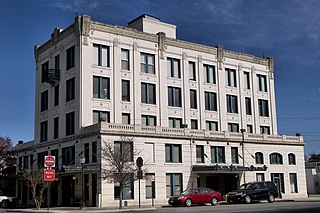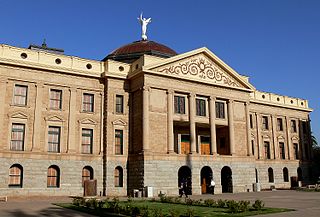
Seguin is a city in and the county seat of Guadalupe County, Texas, United States. The population was 29,433 at the 2020 census, and according to 2023 census estimates, the city is estimated to have a population of 36,013.
Sebastopol or Sevastopol is a city on the Crimean peninsula.

Starr Family Home State Historic Site is a 3.1-acre (1.3 ha) historical site operated by the Texas Historical Commission in downtown Marshall, Texas. It was listed on the National Register of Historic Places in 1979. The museum was made a Recorded Texas Historic Landmark in 1986. On January 1, 2008, the site was transferred from the Texas Parks and Wildlife Department to the Texas Historical Commission.

New Almaden, known in Spanish as Nueva Almadén, is a historic community and former mercury mine in the Capitancillos Hills of San Jose, California, located at the southwestern point of Almaden Valley in South San Jose. New Almaden is divided into two parts: the mines and much of their immediate surroundings, including historic ghost town settlements in the Capintancillas, which together form the Almaden Quicksilver County Park, and the largely residential historic district surrounding the Casa Grande.

The Fulton Mansion State Historic Site is located in Fulton on the Texas Gulf Coast, in the county of Aransas, in the U.S. state of Texas. It is one of the earliest Second Empire style buildings constructed in Texas and is one of the most important of the style in the Southwest United States still in existence. Colonel George Ware Fulton and Harriet Gillette Smith began building the 4 story structure overlooking Aransas Bay in 1874 and finished in 1877. The residence, dubbed "Oakhurst" by its owners George & Harriet, featured the most up-to-date conveniences for the time, such as indoor plumbing reaching sinks in every bedroom, gas lighting and central heating, along with three bathrooms and two built-in copper tubs.

Monument Hill and Kreische Brewery State Historic Sites are two state historic sites managed by the Texas Historical Commission. They are located at 29.888° -96.876°, just off U.S. Route 77, south of La Grange, Texas. The sites sit on a sandstone bluff 200 feet above the Colorado River. Monument Hill is a memorial to the men who died in the Dawson Massacre and in the Black Bean Episode of the ill-fated Mier Expedition.

James Riely Gordon was an architect who practiced in San Antonio until 1902 and then in New York City, where he gained national recognition. J. Riely Gordon is best known for his landmark county courthouses, in particular those in Texas. Working during the state's "Golden Age" (1883–1898) of courthouse construction, Gordon saw 18 of his designs erected from 1885 to 1901; today, 12 remain.

Pike's Stockade is a historic exploration campsite located near Sanford, Colorado. Set on the north bank of the Conejos River, it is where explorer Zebulon Pike raised the American flag on Spanish soil in 1807. The site, now managed by Historic Colorado, includes a reconstruction of a wooden stockade, built according to Pike's detailed description of the original. The site was declared a National Historic Landmark in 1961.

The Sam Rayburn House Museum is a historic house museum at 890 West Texas State Highway 56 in Bonham, Fannin, Texas. Built in 1916, it was home to Sam Rayburn (1882-1961), a famously effective Speaker of the United States House of Representatives. It was declared a National Historic Landmark in 1976. Since 1972, it has been operated as a museum and state historic site by the Texas Historical Commission.

The Roma Historic District in Roma, Texas preserves an intact example of a border town in the lower Rio Grande valley. The town was an important port and transshipment point on the Rio Grande from 1829 to the 1880s.

This is a list of the National Register of Historic Places listings in Guadalupe County, Texas.

Walnut Springs Park in Seguin, Texas is a network of walkways and bridges along the banks of Walnut Branch, a small tributary of the Guadalupe River. The stream is fed by various small springs. The main one near Court St. was filled in for parking, but the water still trickles out from the beneath the fill.

Alfred Giles was a British architect who emigrated to the United States in 1873 at the age of 20. Many of the private homes and public buildings designed by Giles are on the National Register of Historic Places and have been designated Recorded Texas Historic Landmarks. Based in San Antonio, his buildings can be found predominantly in south Texas and northern Mexico. Giles is credited with "a profound influence on architecture in San Antonio."

Casa Navarro is a historic site in San Antonio, Bexar County, in the U.S. state of Texas. The original house complex was the residence of Texas patriot José Antonio Navarro (1795–1871), a rancher, merchant, leading advocate for Tejano rights, and one of only two native-born Texans to sign the Texas Declaration of Independence. Navarro first bought the property, about 1.5 acres, in 1832. The limestone, caliche block, and adobe structures were built c. 1832–1855, and Navarro moved onto the property soon after.

Saffold Dam at the Flores Crossing is a dam and man-made waterfall in the city of Seguin, Texas. Named for William Saffold, a Civil War veteran, a major landowner and local merchant. The dam was listed on the National Register of Historic Places on November 15, 1979.

The Robert Hall House is a historic 1830s home on the Walnut Branch. The house was the residence of the early ranger, Robert Hall (1814–1899). It is among the oldest structures still standing in Seguin, Texas.

Los Nogales is a historic 1800s home, among the oldest structures still standing in Seguin, Texas and is the last remaining adobe constructed home in the city. It serves the community as a museum.

This is a list of the National Register of Historic Places listings in Live Oak County, Texas.
John Esten Park,, educated in chemistry and medicine, experimented with using concrete to construct buildings before the American Civil War. His work left the town of Seguin, Texas, with a large concentration of 19th-century concrete structures.

The Magnolia Hotel is a historic structure located in Seguin, Texas. It was originally built 1840 by James Campbell, as a two room log cabin. It was in operation as a hotel as early as 1844. The building had been in poor repair for a number of years and was added to a list of the most endangered historic places in Texas in 2012. In 2013, the structure came under new ownership of Erin Ghedi and Jim and was being restored for use as a private residence.
























